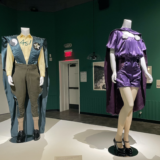One of the challenges of liking anime is having to sometimes admit that you prefer cartoons to more “grown up” forms of entertainment. And sometimes you can defend yourself with a really adult title like Akira or Vampire Hunter D, but sometimes you also have to admit…you really do love stuff that’s geared toward kids!
Eiichiro Oda’s classic manga, One Piece, has been around for fifteen years. For about ten of those years, I actively avoided it; back when I subscribed to Shonen Jump magazine, I would read Naruto instead, preferring the smoother art style and less absurd character designs – even though I’ve always preferred pirates to ninjas. But there’s something to be said about a still-running teenage animanga title, and my more developed sense of artistic appreciation coupled with the need to know “what’s so great about it anyway?” got the better of me; I started season one a couple weeks ago. This, in addition to my recent rediscovery of why I used to love Yu-Gi-Oh! so much, has allowed to me really appreciate the material that Japan has geared toward its children.

It is rare for a children’s television show in the States to appeal beyond the age of eleven; they are formulaic, dumb, and often ugly (though recent titles like Adventure Time are doing a great job of challenging that trend). Even long after I grew out of the “middle reader” age group (9-12, approximately), I continued to read middle-reader novels – and still do – for the better sense of story and character than many television shows have. And I have found, time and again, that really successful animanga geared toward the same general age group is a vast improvement over cartoons in the same way that those novels are.
To start off, this stuff doesn’t coddle your kids; even though evil companies consistently dub out parts of the story that are “too scary/violent/disturbing/difficult for a child to understand,” manga publishers are much better at keeping the unneeded censoring to a minimum. And of course, it’s much easier these days to find the original, uncut versions of anime with subtitles. Many of these series are about fighting, so it makes sense if there’s a little bit of blood – that’s what happens when you kick someone in the teeth!
But it’s not just the senseless violence that make these shows superior; there are certain series that make me cry. Now, I can be an emotional person, but I’m also pretty rational The best anime have stories with characters you can care about, and their histories can move you in ways you didn’t realize. I don’t think a Western cartoon has ever made me cry (I’m just talking about TV cartoons – mentioning The Fox & the Hound or Toy Story 3 in the comments is cheating). The characters in One Piece have lost family members and friends – and the Japanese voice acting is superb; I’ve never heard such realistic crying in anime before. One of the characters in Yu-Gi-Oh! survived a massacre more or less at the hands of the “good guys.” The main character of Yu Yu Hakusho is a horrible delinquent with an alcoholic single mother. Hell, even Usagi’s stupid temporary break up with Mamoru in Sailor Moon brings me to tears because for Usagi the fourteen-year-old girl, it’s a truly life-altering experience that anyone who has ever been a fourteen-year-old girl can sympathize with.

Image from sailormoonnews.com
This is heavy stuff. And I think that Western animators believe that children between the requisite ages don’t have enough of an attention span to follow long, drawn-out stories or care about the conflicts of characters enough to try and reach those kinds of depths. But what’s the last enormous cartoon/merchandise-tie-in trend that wasn’t anime-related or trying to be some kind of anime knock off? I can’t think of any. These series don’t talk down to kids, they’re honest and forthright, and even in the titles that are violent or are of “questionable moral content,” the ideals of friendship and loyalty and perseverance win out. And because the shonen and shojo genres are so popular, new talent is always in demand, meaning these series have some of the most interesting and imaginative art and animation styles.
This method works. This method means that I, as a 23-year-old American female with a job and bills to pay and other big-girl problems to deal with, can press play on an episode of a show intended for a boy half my age and thoroughly, unironically enjoy it. There’s no shame in liking something that has all the best attributes of real quality media – even if its not “for your demographic.”











